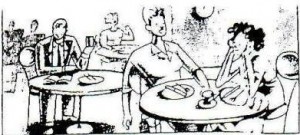work day easy
Work Day, Shop
Vocabulary
| get up | assist | household |
| waffle | turn off | french toast |
| soap | subway | take a subway |
| lock | turn on | pancake |
| truck | deliver | customer |
| shift | nearby | get dressed |
| cash | operate | cash register |
| until | pick up | come by |
| item | owner | look after |
| main | goods | coworker |
Getting Ready
It’s four-thirty in the morning. Betty slowly gets up from her bed.
She goes into the kitchen, cooks and eats breakfast: today it’s pancakes (other times it may be waffles, french toast, sausage and eggs).

Then she takes a shower and gets dressed.
At 5:30 Betty leaves home. After locking the front door, she walks to the bus stop about 75 meters away and waits. She takes the number 19 bus, which brings her to her workplace, a convenience store.
At Work
Betty unlocks the front door and turns on the lights. It’s six o’clock.
Soon delivery trucks come over, bringing fruits, vegetables, meat, bread, and other goods.
Other Tasks
The shop opens for business at seven o’clock. Customers come in. At this time, they are mostly workers picking up something for breakfast or lunch before going to work.
Later shoppers come to buy groceries, household items, newspapers and magazines.

Betty assists them and operates the cash register.
At about noon, Ted, the shop owner comes by. He looks after the store while Betty goes to a nearby restaurant for lunch.
About 45-minutes later, she returns, and Ted goes to his main store.
Finish
Then at three o’clock, Betty’s coworker, Mike comes. He starts working the evening shift, and she returns home.
Mike will stay until he closes the shop at nine p.m.
Back Home
When she gets home, Betty sits on her sofa, drinks tea or coffee, turns on the TV . . . and relaxes.
Later she might go for a walk in the park with her dog, Fido, or visit her friend at her house.
In the evening, Betty cooks and eats dinner. Then she reads a book or surfs the internet.
At about 9:30, she goes to bed.
Questions
1. Betty wakes up very early. True or false?
2. For breakfast, she has . . . . . . . or . . . . . . . .
3. When does Betty leave home? How does she get to work?
4. Can people buy things at the shop at six o’clock? What happens between 6:00 and 7:00?
5. She works with a computer. Yes, no, perhaps, maybe?
6. What do the customers buy? Is the shop big?
7. She eats lunch in the shop. Is this right or wrong? Does she close the shop before going to lunch?
8. Betty owns the shop. Is this correct or incorrect?
9. Who is Mike?
10. What does she do when she gets home?.
Now talk about what you normally do every day.
A. What do you usually have for breakfast? I usually have . . . . . for breakfast.
B. How do you or your parents get to work? I go to work by . . . . . .; I . . . . . to work.
C. What do you or your parents do at work? At work, I . . . . . .
D. Do you take (coffee) breaks from your work or study? Where do you have breaks? What time do employees have breaks?
E. Where do you have lunch? What do you eat for lunch? I have lunch at . . . . . . ; I have . . . . . . for lunch.
F. What hours do you work? What time do you start and finish work? I start work at . . . . and finish at . . . . .


1. 2.


3. 4.


5. 6.


7. 8.


9. 10.


11. 12.

13.

